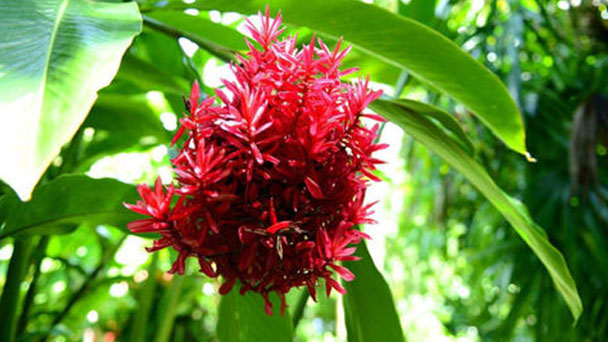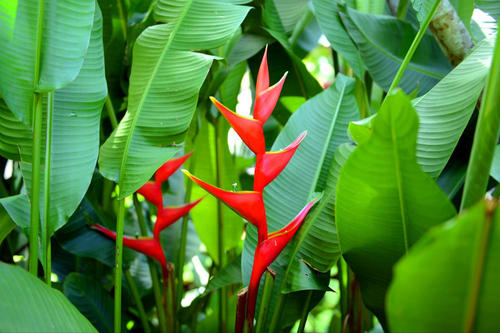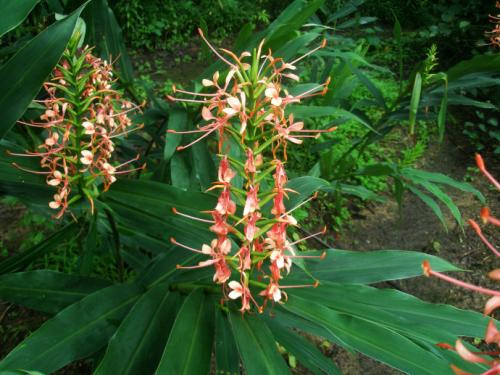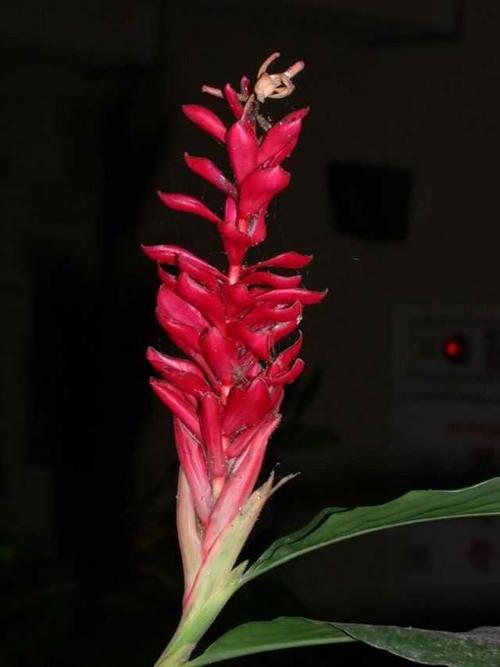Scarlet ginger lily (Hedychium coccineum) profile
Written by Maggie
Sep 11 2021

Scarlet ginger lily (Hedychium coccineum Buch.-Ham.), also called an orange ginger lily, and orange bottlebrush ginger, is a perennial herb in the genus Zingiberaceae, with a height of up to 2m. Leaf-blade is narrow linear, spicate more dense, cylindrical, red flowers. Capsule is dehiscent.
Scarlet Ginger Lily is produced in Xizang, southern Yunnan and Guangxi. scarlet ginger lily grows in the forest, under valley forest, damp shrubbery on the edge of valley forest, in hillside forest, in dense hillside forest, in the miscellaneous wood forest. India, Sri Lanka are also distributed.
Scarlet ginger lily picture

Morphological characteristics of scarlet ginger lily
Scarlet ginger lily is a terrestrial or epiphytic herb with a massive rhizome. The stem is 1.5-2 m tall. Leaf-blade is narrowly linear, 25 -- 50 cm long, 3 -- 5 cm wide, apically caudate, base attenuate or suborbicular, glabrous on both surfaces; Ligule is 1.2-2.5 cm long.
The inflorescence of Scarlet ginger lily is dense, sparse, cylindrical, 15-25 cm long, 6-7 cm in diameter, with stout rachis, glabrous or sparsely pubescent. Bracts are leathery, indentulous or more flattened on dense inflorescences, oblong, acute or obtuse, 3 -- 3.5 cm long, apically pubescent, thinly glabrous, with 3 flowers; Flowers are red, calyx 2.5 cm long, 3-dentate, especially apically pubescent;
Corolla tubes of Scarlet ginger lily are slightly beyond calyx, lobes linear, reflexed, 3 cm long; Lateral staminodes are lanceolate, 2.3 cm long, labellum rounded, ca. 2 cm or smaller in diam., deeply 2-lobed, base with stalk; Filaments are 5 cm long, anthers curved when dry, 7 -- 8 mm long; Ovary is sericeous, 2.5-3 mm long.
Capsule of Scarlet Ginger Lily is spherical, with a diameter of 2 cm; Seeds are red.
Ecological Habits of scarlet ginger lily
Scarlet ginger lily is a semi-shade plant, which likes a warm and humid climate, and the optimal growth temperature is 25-30℃. Scarlet ginger lily has heat resistance, disease resistance, barren tolerance. The optimal growth temperature of Scarlet Ginger Lily was 25-30℃, which could withstand the low temperature of minus -3℃ and the aboveground part did not wilt. Scarlet ginger lily had strong adaptability to the soil, but it was best to plant in loam or sandy loam with rich organic matter, fertile and good drainage.
Scarlet ginger lily propagation
Scarlet ginger lily is generally propagated by split roots, which can be combined with and changed pots in spring. Planting needs to apply sufficient basal fertilizer, growth period topdressing 1-2 times of rarefying nitrogen fertilizer, when the beginning of the flower stem out of the application of phosphorus, potassium fertilizer, so that the flower stem firm, gorgeous.
How to grow and care for scarlet ginger lily
Soil
The soil must be kept constantly moist and slightly dry during hibernation in winter. Spring and summer are suitable times for planting. It is advisable to excavate seedlings of Scarlet ginger lily with underground tubers, and 2/3 of the stems and leaves above ground can be cut off and then planted.
Cultivation soil should be fertile and not easy to dry soil, drainage should be good, full sunshine, half sunshine or half wet shade can grow normally. If the cultivation place often maintains humidity or is close to the water source, the development is more exuberant. Into the plant can be naturally into the cluster, after the flower will bloom stems off, or when necessary, the timing of plastic pruning, cut to the residual branches or dead leaves, for ventilation.
Fertilization
The Scarlet Ginger Lily used decomposable compost or natural fertilizer, applied once every two months. If planted in the flower bed, dry soil can be in the seedling planting, in the plant base around the excavation of the annular small concave groove, after irrigation, water can stay in the concave groove, fully wet root, promote growth. In addition to the method of division, after the adult plant blossoms, the small flowers in the bud can also bear and bud, and produce most buds, which can be planted to raise seedlings.
The cultivation of Scarlet Ginger Lily in Guangzhou can produce seeds, but the number is small and it is not suitable for large-scale reproduction, so sexual reproduction is of little significance. The speed of multiplication by division is also very slow, because the growth potential and meristem ability of Scarlet Ginger Lily are weak, unlike other coronarium varieties, so division propagation is not an ideal method, and rapid factory seedling breeding has been achieved by tissue culture method in studies.
Planting
The Scarlet Ginger Lily is suitable for autumn planting, single or double row planting, fixed row spacing of plants (20-40) × (20-40) cm, with about 4000 seedlings per acre. The plant meristem ability is weak, it is best to adopt the reasonable dense planting way of cultivation.

Disease Control of scarlet ginger lily
Generally, after planting for 3 years, the underground roots and stems of Scarlet Ginger Lily are prone to aging, and the plant regeneration ability and resistance are weakened, leading to the aggravation of diseases and insect pests and the increase of sick and weak plants, affecting the product quality. Therefore, it is necessary to re-divide plants and arrange new fields for crop rotation, which is conducive to the prevention and control of diseases and insect pests, maintain strong plant growth, promote plant regeneration ability, obtain higher yield and improve product quality.
Scarlet ginger lily mainly has the harm of borers (coricularis) drilling into the heart, moth twiddles eating young leaves, mole mantis harming underground tubers, etc. Generally in the early flowering period of May, June vulnerable to the bore borers damage. The adult insect lays eggs at leaf axil or plant top, after hatching drill eats into and harm heart ministry, cause plant top to wither and die, cannot blossom or break flower branch, affect yield and quality seriously.
In prevention and control to prevent, pay attention to observation, in advance of spraying, catch in the adult insect egg-laying period, larva early spraying. It can be used trichlorfon 800 times liquid or batan 1000 times liquid, lesbian 1500 times liquid spray control, continuous spraying more than three times can achieve good control effect.
Distribution region of scarlet ginger lily
Scarlet ginger lily was born in the evergreen broad-leaved forest at the altitude of 700-2900 m (mostly born at the altitude of 900-1400 m).Like warm and wet, shade tolerance.
Scarlet ginger lily is distributed in Xizang (Motuo), southern Yunnan, Guangxi Autonomous Region and Guizhou Province of China. Along with the Himalayan countries and Sri Lanka, Burma, India, Vietnam are also distributed.
Garden use of scarlet ginger lily
Scarlet ginger lily is a rare product of the genus Hedychium, with high ornamental value. Many varieties have been cultivated in Europe and America. Its bright red spikes are suitable for use as new cut flowers or landscaping. The yield of cut flowers per acre is 5000-8000, and the flowering period of cut flowers is 5-7 days.
The whole inflorescence of the Scarlet Ginger Lily is tingling and red as a torch. Its cylindrical style spills out red flowers from all directions. It has a long blooming period and is extremely beautiful. Many horticultural varieties have been bred in Europe and America. Scarlet ginger lily flowers are coarse and easy to tube and can be entered into the garden for viewing with a little taming.

Latest Updated
- Benefits of Bugleweed - 7 Science-backed Health Benefits
- Bugleweed Dangers & Side Effects - Is It Poisonous?
- How to Plant Evergreen Trees - What You Should Know
- When to Plant Evergreens - Grow Guide for Evergreen Trees
- 12 Wonderful Evergreen Shrubs for Your Garden
- 12 Popular Evergreen Plants with Pictures for Beginners
- When And How To Prune A Lilac Bush Like a Pro
- How to Grow & Care for Lilac Vine (Hardenbergia Violacea)
- Japanese Lilac Tree (Syringa Reticulata) Care & Propagation Guide
- Shumard Oak Pros and Cons - What to Know
Popular Articles
- Winter maintenance of Antirrhinum Majus
- How to Grow Terminalia Mantaly Tree
- How to Grow and Care for Crossostephium Chinense
- How to grow Antirrhinum Majus in spring
- Peristeria Elata (Dove Orchid) Profile: Info & Care Guide
- Underwatered Snake Plant (Sansevieria Trifasciata) - Signs And How To Fix
- How to Care for Brazilian Jasmine Plant (Mandevilla Sanderi)
- How to Grow & Care for Graptopetalum Purple Delight in Summer
- Rosa Chinensis (China Rose): Plant Growing & Care Tips
- How to Care for Baby Sun Rose (Aptenia Cordifolia)